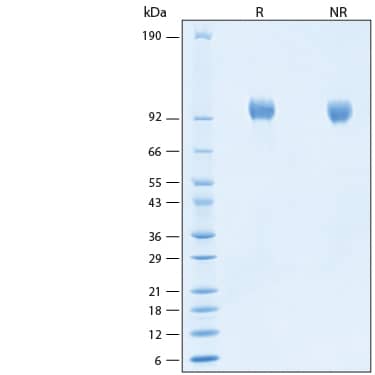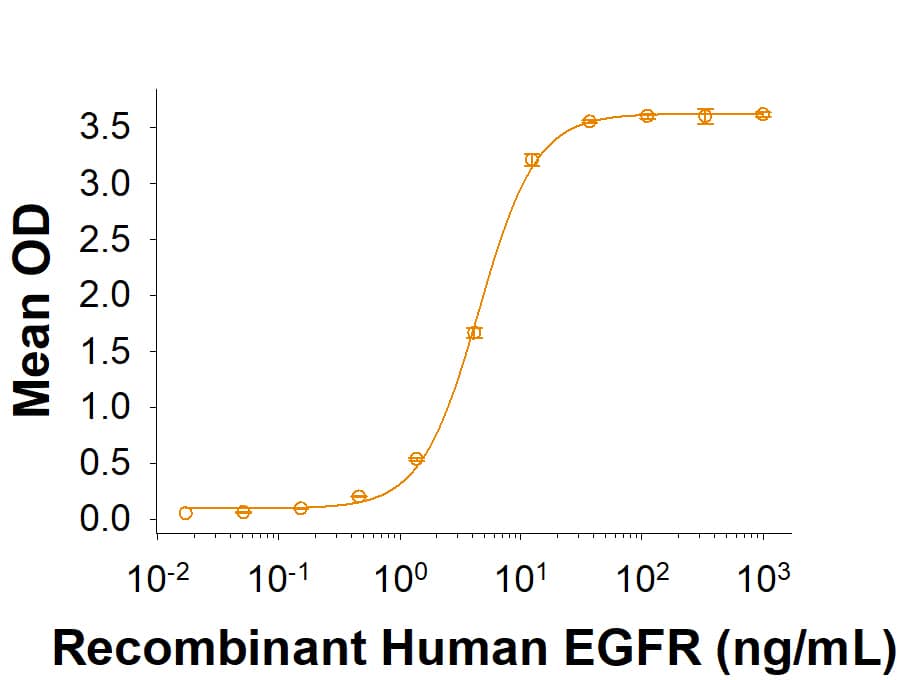Recombinant Human EGFR His-tag Protein, CF
R&D Systems, part of Bio-Techne | Catalog # 11302-ER

Key Product Details
Product Specifications
Source
Leu25-Ser645, with a C-terminal 6-His tag
Purity
Endotoxin Level
N-terminal Sequence Analysis
Predicted Molecular Mass
SDS-PAGE
Activity
When Human EGFR (Research Grade Cetuximab Biosimilar) Antibody (Catalog # MAB9577) is immobilized at 1 µg/mL (100 µL/well), Recombinant Human EGFR His-tag (Catalog # 11302-ER) binds with an ED50 of 1.25-15.0 ng/mL.
Scientific Data Images for Recombinant Human EGFR His-tag Protein, CF
Recombinant Human EGFR His-tag Protein Binding Activity.
When Human EGFR (Research Grade Cetuximab Biosimilar) Antibody (MAB9577) is immobilized at 1 µg/mL (100 µL/well), Recombinant Human EGFR His-tag (Catalog # 11302-ER) binds with an ED50 of 1.25-15.0 ng/mL.Recombinant Human EGFR His-tag Protein SDS-PAGE.
2 μg/lane of Recombinant Human EGFR His-tag Protein (Catalog # 11302-ER) was resolved with SDS-PAGE under reducing (R) and non-reducing (NR) conditions and visualized by Coomassie® Blue staining, showing bands at 94-104 kDa.Formulation, Preparation and Storage
11302-ER
| Formulation | Lyophilized from a 0.2 μm filtered solution in PBS with Trehalose. |
| Reconstitution | Reconstitute at 500 μg/mL in PBS. |
| Shipping | The product is shipped at ambient temperature. Upon receipt, store it immediately at the temperature recommended below. |
| Stability & Storage | Use a manual defrost freezer and avoid repeated freeze-thaw cycles.
|
Background: EGFR
Epidermal growth factor receptor (EGFR), also known as HER-1 and ErbB1, is a member of a subfamily of receptor tyrosine kinases comprised of four members: EGFR, ErbB2 (Neu, HER-2), ErbB3 (HER-3), and ErbB4 (HER-4). All family members are type I transmembrane glycoproteins with an extracellular domain (ECD) containing two cysteine-rich domains separated by a spacer region and a cytoplasmic domain containing a tyrosine kinase domain followed by multiple tyrosine autophosphorylation sites (1, 2). Several soluble isoforms lacking the intracellular domain are generated by alternate splicing, along with a tumor specific mutant EGFRvIII, are known to exist (3-5). The ECD of mature, full-length EGFR shares 88% and 89% amino acid sequence identity with mouse and rat EGFR, respectively. EGFR binds a subset of the EGF family ligands, including EGF, amphiregulin, TGF-alpha, betacellulin, epiregulin, HB-EGF, and epigen (1, 2). Ligand binding induces EGFR homodimerization as well as heterodimerization with ErbB2, resulting in kinase activation, heterodimerization tyrosine phosphorylation and cell signaling (6-8). EGFR can also be recruited to form heterodimers with the ligand‑activated ErbB3 or ErbB4. EGFR signaling regulates multiple biological functions including cell proliferation, differentiation, motility, and apoptosis (6-8). EGFR is overexpressed in a wide variety of tumors, with EGFRvIII overexpressed particularly in glioblastoma multiforme (GMB) and is the target of several anti-cancer therapeutics (5,9,10).
References
- Singh, A.B. and R.C. Harris (2005) Cell. Signal. 17:1183.
- Shilo, B.Z. (2005) Development 132:4017.
- Guillaudeau, A. et al. (2012) PLoS One. 7:1.
- Reiter J.L. et al. (2001) Genomics 71:1.
- Gan HK et al. (2013) FEBS J. 280:5350
- Freed, D. M. et al. (2017) Cell. 171:683.
- Burgess, A.W. et al. (2003) Mol. Cell 12:541.
- Faria, J.A. et al. (2016) BBRC. 478:39.
- An Z. et al. (2018) Oncogene. 37:1561.
- Lee, C. K. et al. (2017) J. Thoracic Oncology. 12:403.
Long Name
Alternate Names
Gene Symbol
UniProt
Additional EGFR Products
Product Documents for Recombinant Human EGFR His-tag Protein, CF
Product Specific Notices for Recombinant Human EGFR His-tag Protein, CF
For research use only

